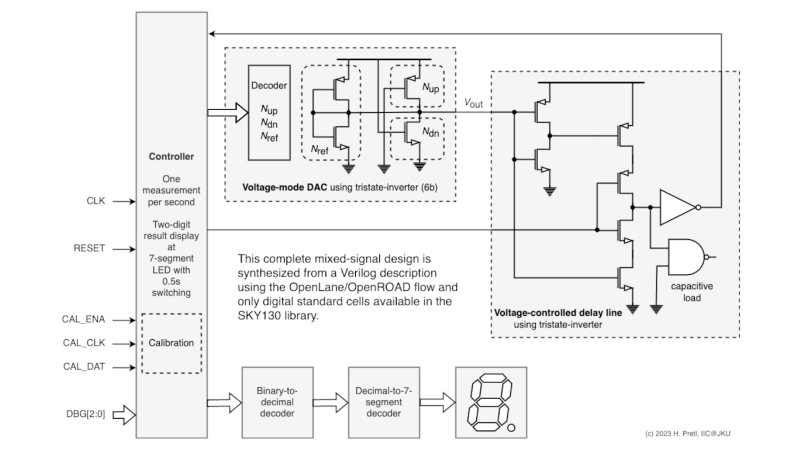Tiny Tapeout is a way for students, hobbyists, and home gamers to get their own ASICs designs fabbed into real custom chips. Tiny Tapeout 3 was the third running, with designs mandated to be made up of simple digital standard cells. Only, a guy by the name of [Harald Pretl] found a way to make an analog circuit using these digital cells anyway.
In a video on YouTube, [Harald] gave an interview on how he was able to create a temperature sensor within the constraints of the Tiny Tapeout 3 requirements. The sensor has a range of -30 C to 120 C, albeit in a relatively crude resolution of 5 degrees C. The sensor works by timing the discharge of a pre-charged parasitic capacitor, with the discharge current being the subthreshold current of a MOSFET, which is highly dependent on temperature. [Harald] goes deep into the details on how the design achieves its full functionality using the pre-defined digital cells available in the Tiny Tapeout 3 production run.
You can checkout a deeper breakdown of [Harald]’s design on the submission page. Meanwhile, Tiny Tapeout creator [Matt Venn] gave a great talk on the technology at Hackaday Supercon last year.
Thanks to [Adrian] for the tip!
















A neat reminder that digital circuits are made from analog components which means in the right arrangement they can maintain their analog nature.
Hm..what kind of design you need to make yourself that you can’t buy in better
quality today?
Olaf
Did you check the name if this website? Your comment tells a lot about you and nothing about the post itself. Its not about the destination, its about the journey.
You can spent 250h and 250€ for your design and you get something that you can buy for 2,5€. But in this case you are paying 250€ for 250h of educating fun – 1€ per hour. And get desired part free on top of that! ;)
What do you learn when you buy something instead of making it yourself?
Wow! I designed an ASIC as part of my PhD dissertation in the early 1980s using the MOSIS foundry. The idea that this is available now for these prices is just unfathomable.
One of the kinda cool things about subthreshold conduction is if you can get a decent transfer function out of it, it operates at like 1% of the power budget of the fet operating in its normal range.
Ambiq Micro uses subthreshold to bring impressively low power processors.
To make things in unusual way requires understanding, and this inspires other people to be creative. Very nice!